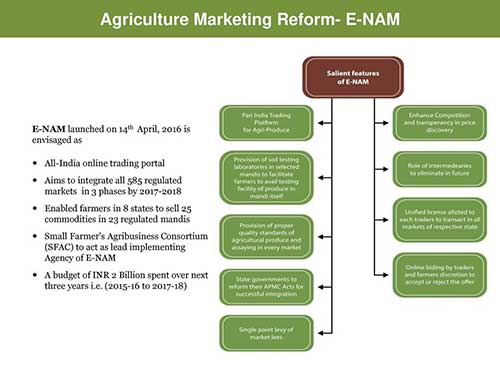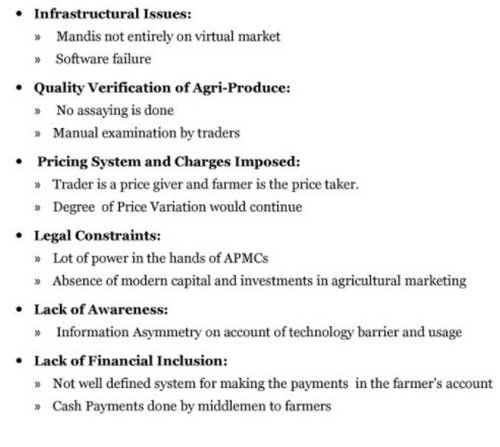Relevance: GS-2: Government policies and interventions for development in various sectors and issues arising out of their design and implementation.
Key Phrases: e-NAM, APMCs, single-point tax, assaying lab, AGMARKNET, mandis, e-NWRs.
Why in News?
- The value of total transactions on the government-controlled electronic National Agriculture Market (e-NAM) has zoomed to a record in the first ten months of the current fiscal against the transactions witnessed since it was launched during 2016-17. The higher transaction is seen as a success of moving towards the digital and online platform by the stakeholders.
Context:
- Total transactions over e-NAM was ₹42,163 crore during April-January of the current fiscal against ₹31,366 crore entirely in 2020-21, sources said. If the transactions continue at the current rate, the business during this year could touch ₹46,000 crore, sources said.
- In 2020-21, the turnover on e-NAM, an online platform connecting 1,000 Agricultural Produce Market Committee (APMC) mandis across the country, witnessed 10.2 per cent drop at ₹31,366 crore against ₹34,940 crore in the previous year.
- Rajasthan, Haryana and Andhra Pradesh continue to be the top three performers on the e-NAM platform, clocking 73 per cent of the total transactions this year, whereas their combined share was 66 per cent in last year’s trade value. Good performers have not only sustained the interests of farmers and traders but exceeded have their targets.
- According to the e-NAM portal, out of 1,000 mandis integrated under e-NAM, online trading is taking place on 571 market yards.
- Guntur in Andhra Pradesh continues to top APMC mandis with a turnover of ₹4,025 crore in April-January, against ₹2,173 crore in the whole of 2020-21. Sirsa mandi in Haryana has been relegated to the third position by Rajasthan’s Jaipur (fruits and vegetables) mandi, which is number two in terms of turnover at ₹ 1,236 crore.

-
Electronic National Agriculture Market (e-NAM) is a pan-India electronic trading portal for Agri-produce, launched in April 2016 to create a unified national market for agricultural commodities by networking existing Agriculture Produce Marketing Committees (APMCs).
-
e-NAM was constructed with the goal of creating a seamless national market where buyers and sellers can transact without being in the same location. Through e-NAM platform, more buyers can bid for a specific lot. The dispersed set of online buyers bidding anonymously reduces the opportunities traders have for colluding. This is the main advantage of e-NAM.
-
Under e-NAM, one license issued for a trader is valid across all markets in the State. Also, a single-point tax of market fees on the first wholesale purchase from the farmer. For local traders in the mandi, e-NAM offers the opportunity to access a larger national market for secondary trading. For the farmers, it increases access to markets through warehouse-based sales and thus reducing the need to transport his produce to the mandi.

Challenges faced by e-NAM:
There are a few challenges which e-NAM faces:
- Data of trading done manually was being fed into the electronic platform of E-NAM after the auction was completed. This was in complete violation of the concept of transparency and discovery of a fair price.
- In such APMCs strictly speaking, online auction of commodities on e-NaM platform is not taking place and the data of manual trading is being recorded into the system after the auction is done offline.
- Many APMCs are lacking in operational assaying lab for grading of the commodities prior to putting them for online auction, while few were pushing out commodities will large arrival volumes from e-auction due to time constraint.
- There also found significant variation in the arrival data of AGMARKNET and e-NAM, as AGMARKNET data records actual transaction data while e-NAM records the data captured at the arrival gate of the APMC.
- Though some of the labs do have some basic instruments like moisture meter and weighing machine etc., this is a major deficiency noticed in majority of APMCs thereby affecting the prospect of introducing online trading platforms in such APMCs.
Other challenges

Way forward:
- Despite all the hiccups, e- NAM has stayed afloat and grown in terms of volume and reach. Several new features that include real-time weather data etc have been added to the platform.
- APMCs need to be well equipped with the basic assaying equipment including automatic analysers for both physical as well as chemical quality.
- In order to operate the e-NAM at its full potential and to pass on the intended benefit to the farmers, the government should ensure that each e- NAM or APMC must have appropriate storage facility to provide cost effective warehousing facilities to the sellers (farmers) so as to avert distress sale, there should be prompt payment to farmers.
- Buyer irrespective of his location, should participate in any market of his choice and an institution to support inter-mandi trade and movement of produce, including dispute resolution mechanism should be established.
- Auctions of the produce should take place simultaneously on one common electronic platform in all APMC markets in the country, as well as in the private markets, as and when they come to be established.
- There should be competition among APMC mandis and local officials of mandis should be awarded at the national level to motivate them for better results on e-NAM. There should also be increased financial support from Centre to e-NAM centres inside mandi to popularise the online platform.
- Government needs to focus on inter-state trading by providing third-party guarantees on the quality of the produce transacted on the platform. Unless an entity is ready to take that responsibility, the objective of e-NAM will not be fulfilled.
- Instead of focussing on more addition of mandis, which could not be achieved, hand-holding of existing mandis should be done to increase transaction over e-NAM.
Source: The Hindu BL
Mains Question:
Q. “e-NaM has grown in terms of volume and reach in last 5 years, but e-NAM is still some distance away from the “One Nation One Market” vision”. Critically analyse the statement.







